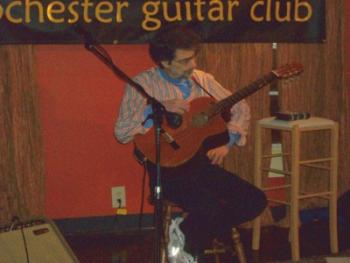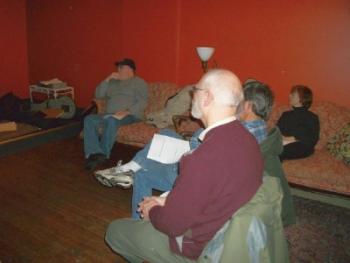Kinloch Nelson's Presentation on "Alternate Tunings" on January 17, 2011
A surprising number of people braved the sub-zero weather on their Monday holiday (Martin Luther King Day) to stop by Abilene’s Bar and Lounge in downtown for the presentation to be given by RGC co-founder and pro guitarist Kinloch Nelson on the subject for which he also wrote a book eponymously titled “Alternate Guitar Tunings.”

Kinloch explains...
Before delving into alternate tunings, we first examined standard tuning.
(for the most part, the following was taken straight out of the informational packet written by Kinloch and handed out at the meeting)
“There have been guitar-like instruments around since around 1400 BC, and it’s anybody’s guess as to how they were tuned. Standard six string guitar tuning (EADGBE, from low to high) first appeared around the year 1700 taking firm hold around 1800. It became standard because it was “handy” (pun intended). The strings are tuned mostly in fourths. Humans have four fingers. Counting the open notes and the first four frets; a human with four fingers on their fretting hand can play through a chromatic scale without leaving first position. A full two octaves are within reach and a huge range of melodies can be played, making it perhaps the most versatile tuning.”
Some of standard tuning’s limitations on the other hand are that closely voiced chords are often difficult or physically impossible to accomplish, and the harmonic overtones are not as prevalent. These happen to be two of the areas in which altered tunings excel. Kinloch demonstrated this by tuning his guitar to DADEF#D and playing the Gordon Lightfoot song “Early Morning Rain.” He also remarked that it was one of the few tunes he knew how to sing. After an abridged performance of the song he broke it down and analyzed it. It’s a simple pop song using only three chords. (I, IV, and V) Most of the voicings used in the arrangement were made using only two fingers on the fretting hand sliding the same shape up and down, while allowing the open strings to drone other notes within the scale.
This is a technique that was made famous by Joni Mitchell. She was stricken with Polio at a young age and lacked the strength in her hands to play the music she wanted in standard tuning, so she altered the tuning to meet her needs. Using this same idea, he constructed harmonized scales on strings 3, 4, and 5 and moved them all the way up the neck while leaving strings 1, 2, and 6 open to illustrate that even though those open strings imply a tonic chord with every strum, the implied tonality of the triad created on strings 3, 4, and 5 will still show through. This gets the same point across as a fully voiced chord, but allows for tighter voicings and richer harmonics.
On the subject of harmonics, he also proposed an interesting metaphor; that the tuning of a guitar is the wallpaper in a room. You can move your fingers (the furniture) any place on the fretboard (in that room), but the open strings (wallpaper) will always be visible. As you play, certain notes excite and sound sympathetic notes in adjacent strings without actually having to pick them, giving a fuller and more complex harmonic landscape. When the open strings are tuned to notes in the key of the song being played (if you arrange your furniture in such a way that it compliments your wallpaper), then your guitar will sound those overtones and harmonize with itself. (your wallpaper will “pop”)
Other tunings were discussed:
DADGBE (Drop D Tuning)
CADGBE (Drop C Tuning)
DGDGBD (Open A Tuning)
DADGAD
DADF#AD (Open D Tuning)
In what he called “C Tuning” (CGDGBE), he played his arrangement of the 1959 Santo & Johnny hit “Sleepwalk.” He also provided sheet music with standard notation and tablature for this song in his free informational packet, as well as an instructional DVD offered for sale at a highly discounted rate to club attendees.
The final tuning discussed was Open C Tuning. (CGCGCE) In this tuning he performed and discussed the John Fayhe song “Sunflower River Blues,” for which he also provided sheet music.
You may ask yourself: “There is an awful lot of information here. Where do I get started?” Mr. Nelson offered this last bit of information on that:
“Altered tunings can loosely be categorized into two types: 1.) A tuning that is standard tuning with only one or two strings changed, usually the bass strings. The rest of the strings stay the same, and therefore “look, sound & behave like standard tuning.” 2.) All the other tunings…that is to say too many strings have been changed for the tuning to be like standard tuning anymore. Getting to know one or more new tunings in some ways is dependent on your mode of playing. Here is what I mean.”

A captive audience...
“There are several methods of playing the guitar: sight reading, playing by ear, you-show-me-I-play-it, improvising and making stuff up, and playing from memory. If you sight read TAB you can start playing in alternate tunings right now. Most alternate tuning songs that are written out these days are written in TAB. So just go find some transcriptions. If you play by ear then you are familiar with the hunt-and-peck method. I suggest you start anywhere and see what happens. If you are the you-show-me-I-play-it type you can learn from a friend or a teacher, or buy video instruction, or head for YouTube. If you are an improviser then you have either a studied or a visceral understanding of music and guitar playing and I suggest you start by matching the sixth string to whatever key you are playing in, develop new bass possibilities and go from there. If you play from memory then you are already all of the other types.”
Kinloch delivered a lot of potentially dry information with humor and wit keeping things lively and interest piqued. I know I walked away from this presentation with a lot of useful information and ideas, and hope that the rest of the attendees did as well.
Mark Grover
Photos: R. Taglieri
The first two pages of Kinloch’s handout are available for downloading and printing here.
Outline of the Presentation:
1. A brief discussion of why Standard Tuning is the norm.
2. Starting from Standard Tuning and developing alternate tunings from there.
3. Some common and some not so common Alternate Tunings.
4. Simple Fingerings to create or imply full chords, complex chord fingerings, a few scales & arpeggios.
5. Using things you know in Standard Tuning to inform the learning process in an Alternate Tuning.
6. Harmonic content: the “tuning’s voice.”
7. Notation Methods and keeping track of tunings using TAB, standard notation, and “chicken scratching.”
8. Handouts: Tunings list; diagrams; picking patterns and other tricks, lists of songs, players and suggested books.
9. A song or two to take with you.
Share this page: ![]() Facebook
Facebook
![]() Del.icio.us
Del.icio.us
![]() StumbleUpon
StumbleUpon
![]() Digg
Digg
![]() Reddit
Reddit
Home ::
About Us ::
Events ::
Articles ::
Resources ::
Contact Us ::
Links
©2007-2012, Rochester Guitar Club, All Rights Reserved, This page last updated 2013-11-13 11:15:08
Website by Red Beagle Web Development.








